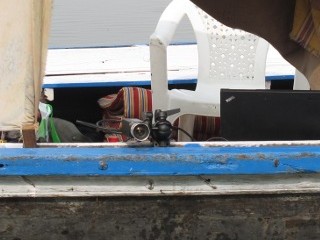July 19, 2012
by Olga Filippova

Tuesday August 7th – Thursday August 9th
Los Angeles Convention Center, Main Hall , Booth 1058
Elphel will present Eyesis4Pi – high resolution full sphere stereophotogrammetric camera at SIGGRAPH 2012, together with it’s calibration machine. We will demonstrate full calibration process to compensate for optical aberrations, allowing to preserve full sensor resolution over the camera FOV, and distortions – for precise pixel-mapping for photogrammetry and 3D reconstruction.
All Elphel camera users are welcome, current and prospective, as well as parties interested in Eyesis4Pi. Here (booth 1058 – see plan) you can talk to the camera developers, see the calibration process and touch the actual working hardware. There is a number of passes available for exhibition only. Please contact Olga Filippova if you would like to receive one.
February 22, 2012
by Andreas Bean

Seeing the impressive images of the Elphel-Eyesis 4pi camera I thought it’s time to tell you about the HomeSide 720°. Like the Eyesis its purpose is to capture panorama frames with a framerate of 5fps. The major difference is that the HomeSide 720° is mounted on a helmet. To have an acceptable weight it consists of only two instead of eight Elphel 353 delivering one forth of the resolution the 4pi does. Thus the camera is able to record 30MPix frames before stitching. Additionally it’s reconfigureable to enable HDR panorama frames.
More interesting probably is the purpose it was built for. We created the assembly for indoor virtual tours. After several drawbacks we finally have an approach which works very well. We do auto leveling, auto stabilization and path extraction by image analysis only. Furthermore we recognize crossing points where the user can decide where to go when the tour is shown in the player.
This is not so easy since we neither have GPS nor IMU data. Nevertheless its possible.
All this information goes into our new webplayer which reassembles the images to a virtual tour.
Have a look at the HomeSide 720° Virtual Tour
Click into the player and use the cursor keys to navigate. You may also click and drag to change the point of view. This tour was recorded with 10MPix i.e. one Elphel 353 with two sensors.
Important: The pi symbols shows a rendered tour, not recorded by the camera
At the moment we are improving the image quality. We are also looking for a partner to drive the development even faster to create stunning indoor virtual tours.
February 10, 2012
by M@sh
It has been a long while since my last blog entry in regards to river view panoramas. In the meantime the recording setup runs basically stable (putting aside minor problems with loose connectors) even under rough conditions (see also the gallery “Making Of” at the end of this post).
I just came back from artist-in-residency stays in Varanasi/Benares and Guwahati in India, that enabled me to have a few extensive recording sessions on various vessels like house boats, motor and rowing boats on Ganges River – for one the most sacred river to Hindus and probably most worshipped river on the planet, next to being one of the most polluted rivers of the world – and Brahmaputra River in Assam.
(more…)
October 31, 2011
by Andrey Filippov
Motivation
While working on the second generation of the Eyesis panoramic cameras, we decided to try go from capturing the series of the individual panoramic images to the 3d reconstruction. There are multiple successful implementations of such process, we just plan to achieve higher precision of capturing the 3d worlds using Elphel ability to design and build the hardware specific for such purpose. While most projects are designed to work with the standard off-the-shelf cameras, we are working on building the cameras together with the devices and methods for these cameras calibration. In order to be able to precisely determine the 3-d locations of the features registered with the cameras we plan first go as far as possible to precisely map each pixel of each sub-camera (of the composite camera) image to the ray in space. That would require at least two distinctive steps:
(more…)
October 12, 2011
by Oleg Dzhimiev
| We have finally received the parts for Elphel-Eyesis-4π camera and started assembling them hoping that all will fit together as we planned. And for the most part they do, which seems a bit like magic to us: you design the camera on the computer in a 3D CAD program, make a long list of parts it will consist of and then a couple months later it all turns into physical object, not just a virtual 3D design.
Of course some of the parts will need minor modifications – some are due to mistakes made by us, and some are manufacturing problems. But none of them were significant enough to prevent us from assembling the first 3 prototypes, that will be 100% operational spherical panorama cameras. Elphel-Eyesis-4π is the second generation Panoramic Imaging System by Elphel Inc. It is able to capture high-resolution images in full 360 degrees and create 4π (in steridians) spherical panoramas at a high frame rate. The actual recording device consists of a weatherproof camera head that contains the image sensor front-ends and lenses in spherical distribution to cover the entire 360 degree area. The rest of the electronic components as well as the SSDs for data storage are contained inside the camera pole.
Elphel-Eyesis-4π covers a full sphere. 24 sensors (8 in horizontal array, 8 pointing at +30 to + 90 degree (zenith) and 8 pointing at -30 to -90 degree (nadir) ensure a uniform high resolution distribution over the entire covered area. A new Internal Measurement Unit (IMU) mounted at the top of the camera pole provides high resolution 3D position and orientation of the camera. |
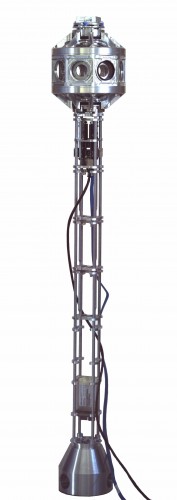 Fig.1. Test assembly. |
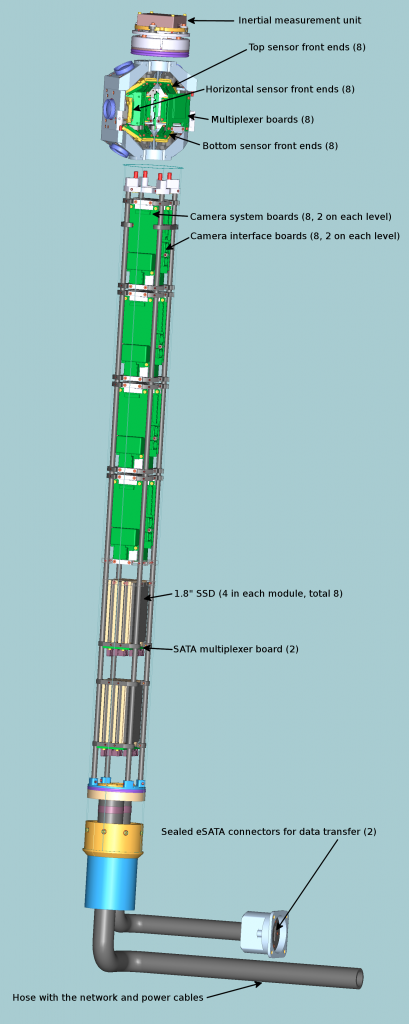 Fig.2. 3D CAD rendering. |
(more…)
June 15, 2011
by Andrey Filippov
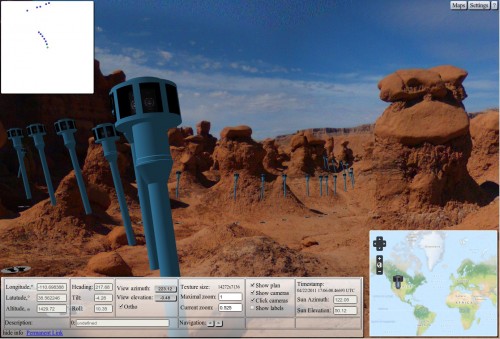
WebGL Panorama Editor (view mode)
This April we attached Eyesis camera to a backpack and took it to the Southern Utah. Unfortunately I did not finish the IMU hardware then so we could rely only on a GPS for tagging the imagery. GPS alone can work when the camera is on the car, but with a camera moving at pedestrian speed (images were taken 1-1.5 meters apart) it was insufficient even in the open areas with a clear view of the sky. Additionally, camera orientation was changing much more than when it is attached to a car that moves (normally) in the direction the wheels can roll. Before moving forward with the IMU data processing we decided to try to orient/place some of the imagery we took manually – just by looking through the panoramas, adjusting the camera heading/tilt/roll to make them look level and oriented so the next camera location matches the map. Just tweaking the KML file with the text editor seemed impractical to adjust hundreds of panoramic images so we decided to add more functionality to our simple WebGL panorama viewer, make it suitable for both walking through the panorama sets and for the editing orientations and locations of the camera spots. (more…)
May 19, 2011
by Andrey Filippov
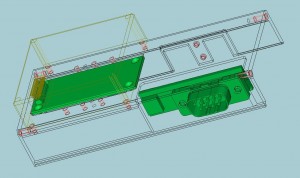
CAD rendering of the Analog Devices ADIS-16375 Inertial Sensor, 103695 interface board and 103696 serial GPS adapter board attached to the top cover of NC353L camera
For almost 3 years we had a possibility to geo-tag the images and video using external GPS and optional accelerometer/compass module that can be mounted inside the camera. Information from the both sensors is included in the Exif headers of the images and video frames. The raw magnetometer and accelerometer data stored at the image frame rate has limited value, it needs to be sampled and processed at high rate to be useful for the orientation tracking , and for tracking position it has to be combined with the GPS measurements.
We had developed the software to receive positional data from either Garmin GPS18x (that can be attached directly to the USB port of the camera) or a standard NMEA 0183 compatible device using USB-to-serial adapter. In the last case it may need a separate power supply or a special (or modified) USB adapter that can provide power to the GPS unit from the USB bus. (more…)
April 26, 2011
by Olga Filippova
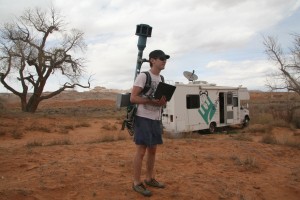
Eyesis Backpack with Netbook for initial set-up
Tacking high-resolution panoramic images in the remote places, that can only be accessed by feet is an option now available with the Elphel-Eyesis 360 degree panorama camera. The camera’s size (1.3 x 0.3 meters) and relatively light weight (10kgs) allow to mount it on a backpack frame and carry by a person.
There were multiple requests for the backpack option by our customers since the development of Elphel-Eyesis camera, but other projects were of higher priority, until this spring, when we finally decided it was time to take Eyesis hiking. After all, we have worked hard on this project for many months, so we ought to have some fun with it too, and take panorama images of the places we knew and enjoyed for it’s scenery.
On April 19th, 2011, we took the Elphel mobile office to camp for 5 days in Southern Utah near the Goblin Valley State Park to try out Eyesis in beautiful places not yet available in continuous panoramic imagery, mainly because of their inaccessibility for car, ATV, or even a tricycle.
Hiking with Eyesis in the backpack (30 lbs/14 kg total weight with the battery pack) allows us to capture a continuous stream of geotagged (GPS) 360° panoramic images. With the current battery pack (just a regular UPS with lead battery) we can take up to one hour and forty minutes of footage at a rate of 5 frames per second.
(more…)
March 30, 2011
by Oleg Dzhimiev
UPD: Google has updated their Salt Lake City images in their StreetView – so, the comparison is better now.
Click here for the active view (resizeable)
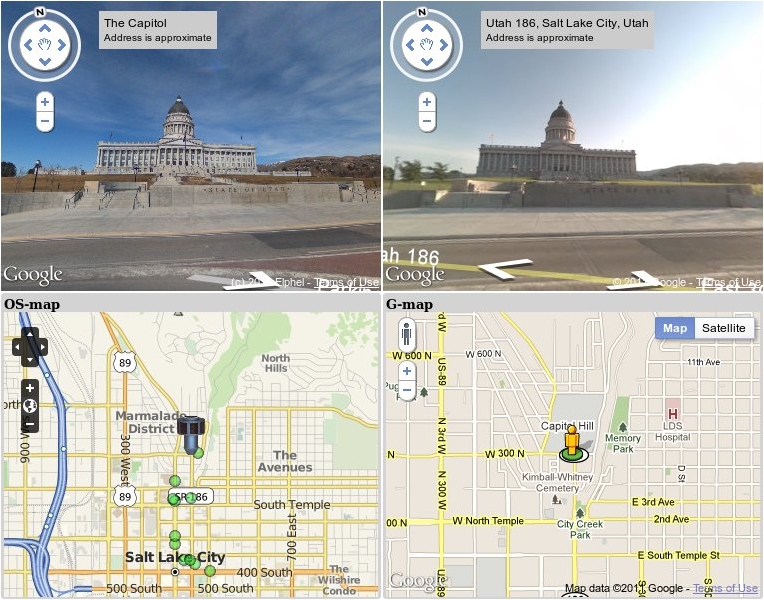
Description
Works in Firefox 4.0 and Chrome. Does NOT work in Firefox 3.6.X.
The above sample shows how custom panoramas (in our case: a panorama we shot with our Elphel Eyesis) can be integrated in a custom StreetView.
Elphel Eyesis images is the top-left window. The top-right window is the current (lower resolution) official Google Street View in Salt Lake City supposedly made by the 2nd or 3rd generation of GSV cameras.
The Open Street Map is for switching between the available panorama points and the Google Map with a pegman is filling the otherwise unused space at the same time generously showing the view direction.
(more…)
February 28, 2011
by Andrey Filippov
Current state of the Eyesis project,
what worked and what did not. Or worked not as good as we would like it to
Most of the last year we spent developing Eyesis panoramic cameras, designing and then assembling the hardware, working on the software for image acquisition and processing. It was and continues to be a very interesting project, we had to confront multiple technical challenges, come up with the solutions we never tried before at Elphel – many of these efforts are documented in this blog.
We had built and shipped to the customers several Eyesis cameras, leaving one for ourselves, so we can use it for development of the new code and testing performance of the camera as a whole and the individual components. Most things worked as we wanted them to, but after building and operating the first revision of Eyesis we understood that some parts should be made differently.
(more…)
« Previous Page —
Next Page »


